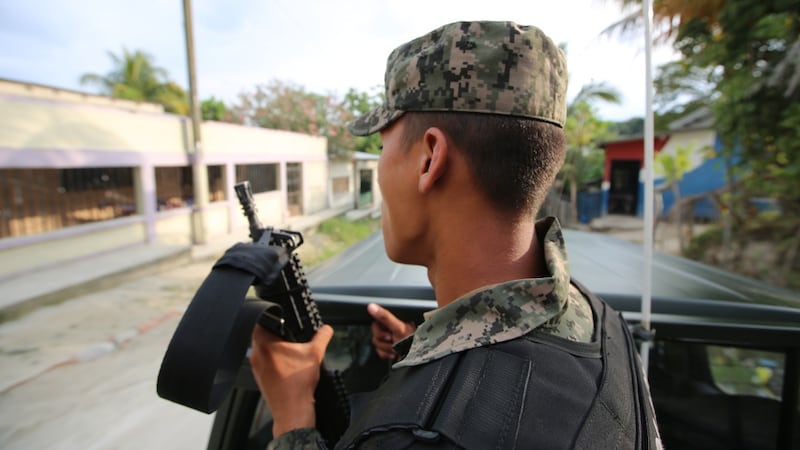[ irishtimes.com/coffeevsgangsOpens in new window ]
Our driver rolls down all the windows of our SUV as we approach the gates of the military police compound near the centre of San Pedro Sula. In a city famous for its drive-by murders and attacks on the police, he doesn’t want to give anyone any doubt as to who is inside.
A soldier walks up to the car with caution, his gun cradled in his hands. He looks inside, checks our credentials and listens as our fixer explains that he has arranged for us to meet some senior staff. He’s also hoping that we might get out on patrol with a military convoy but he doesn't mention this to the gate security. (The Kenco farm we're here to visit is in a rural area far from San Pedro Sula. The students working there are from a mix of urban backgrounds and, in the main, have been brought up in very poor neighbourhoods with a lot of experience of gangs and criminality. In order to better understand where they came from we wanted to visit a local neighbourhood or Barrio.)

We’re nervous, but we've been told that going out with the military is the only safe way to get inside a barrio – one of the local communities that make up this city of over one million people. Many barrios remain in the control of the gangs but some, such as the one we hope to visit, has been retaken under the control of the military.
Inside the compound our credentials are checked again before we’re given a tour of the complex. It's surprisingly relaxed, with soldiers taking time out playing football or chatting in the grounds. They’re eager we learn about FUSINA, the integrated departmental response that the Honduran government has put in place to combat criminality and violence. It’s headed up by the military, they explain, but includes all the state bodies required to plan and deal with criminality and emergencies. We're brought inside their HQ - office doors bear the insginias of the red cross, the national police, the directorate general of migration. It's a one-stop shop for crisis management they say and seem proud of what they have built.
We've heard a lot of criticism of the police since we arrived. Corruption is rife, according to many, while others criticise the huge imbalance between the military and police budget and that of health and education. It's hard to know where the facts and propaganda begin and end. FUSINA has its own Facebook page with news and photos of gang members recently apprehended, some with obvious signs of a beating. They want us and the public to believe they are making progress.
Eventually we get clearence to join a patrol in a barrio that the military regained control of in February. We drive in the first of a three-truck convoy. The soldiers with us are heavily armed and sit in groups of six high on the back of a flatbed truck. Visibility on the streets is obviously part of their strategy and as we drive locals watch us very carefully, taking a surprised second look at the gringo in the back. Children run alongside and wave when they see me, older men salute the police, apparantly in support. According to the commandant who is with us, this barrio has seen rapid change since they retook control. He won't go into specifics as to how they achieved that but cites statistics for the reduction in deaths that if they were true would be quite extraordinary.
Gang graffitti is still visible on some walls. It's a very poor area, desperately so, with warrens of boarded up shacks and tin roof homes. If gangs were actively in control here I could see how hard it would be to live safely. I ask to stop and to speak to some locals. The convoy pulls in and the commandant and I are surrounded by a walking patrol of police. I don't feel under threat but I do feel like a sitting target and am aware that this is not a normal situation.
I speak to some local people, who are naturally cautious about criticising the security situation with some 20 armed police looking on, but one woman does explain that yes, when the police are out it's safe but once they go they are on their own again. She tells me that taxis won't come there at night because it is simply too dangerous. But the commandant is quick to disagree. He suggests we return at midnight to test the case. Luckily, before I get the chance to decline coming back here at night, he gets a call that the convoy is required to police a traffic accident and suddenly we're back on the road again.









